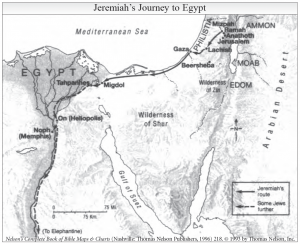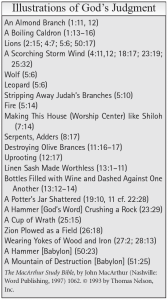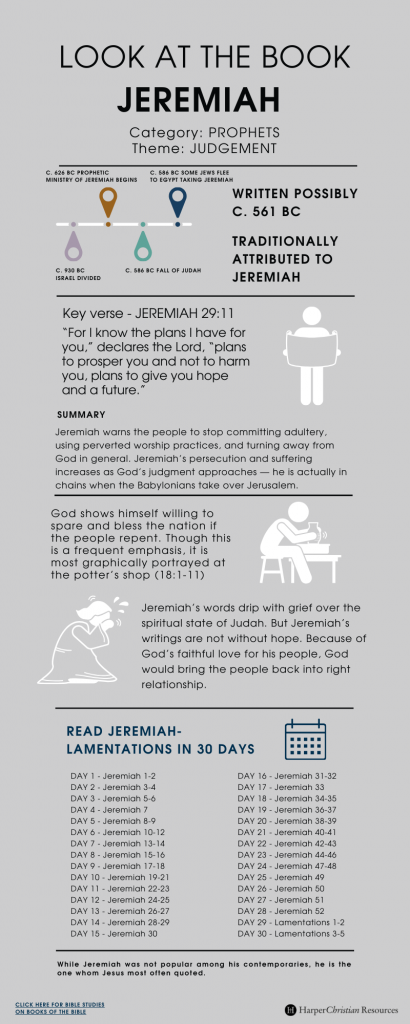by John MacArthur
Jeremiah recounts more of his own life than any other prophet, telling of his ministry, the reactions of his audiences, testings, and his personal feelings. Jeremiah served as both a priest and a prophet and was the son of a priest named Hilkiah. He was from the small village of Anathoth (1:1), today called Anata, about 3 mi. NE of Jerusalem in Benjamin’s tribal inheritance.
As an object lesson to Judah, Jeremiah remained unmarried (16:1–4). He was assisted in ministry by the scribe Baruch, to whom Jeremiah dictated and who copied and had custody over the writings compiled from the prophet’s messages (36:4,32; 45:1). Jeremiah has been known as “the weeping prophet” (9:1; 13:17; 14:17), living a life of conflict because of his predictions of judgment by the invading Babylonians. He was threatened, tried for his life, put in stocks, forced to flee from Jehoiakim, publicly humiliated by a false prophet, and thrown into a pit.
Download an Infographic on Jeremiah
Jeremiah carried out a ministry directed mostly to his own people in Judah, but which expanded to other nations at times. He appealed to his countrymen to repent and avoid God’s judgment via an invader.
The dates of Jeremiah’s ministry, which spanned 5 decades, are from the Judean king Josiah’s 13th year, noted in 1:2 (627 B.C.), to beyond the fall of Jerusalem to Babylon in 586 B.C. After 586 B.C., Jeremiah was forced to go with a fleeing remnant of Judah to Egypt. He was possibly still ministering in 570 B.C.
Download an Infographic on Jeremiah
The main theme of Jeremiah is judgment upon Judah with restoration in the future messianic kingdom. Whereas Isaiah devoted many chapters to a future glory for Israel, Jeremiah gave far less space to this subject. Since God’s judgment was imminent he concentrated on current problems as he sought to turn the nation back from the point of no return.
A secondary theme is God’s willingness to spare and bless the nation only if the people repent. Though this is a frequent emphasis, it is most graphically portrayed at the potter’s shop (18:1–11). A further focus is God’s plan for Jeremiah’s life, both in his proclamation of God’s message and in his commitment to fulfill all of His will (1:5–19; 15:19–21).
Go through the first lesson of Jeremiah & Lamentations:
In the twelve studies within, join John MacArthur on an exploration of this “weeping prophet” and the prophecies he faithfully related to them for more than fifty years. By working through this study, you will learn that in your life—just like in the lives of the people of Judah—God may discipline you for a season, but He will always extend His grace to you.
Widely known for his thorough, candid approach to teaching God’s Word, John MacArthur is a popular author and conference speaker. He has served as pastor-teacher of Grace Community Church in Sun Valley, California, since 1969. John and his wife, Patricia, have four married children and fifteen grandchildren. John’s pulpit ministry has been extended around the globe through his media ministry, Grace to You, and its satellite offices in seven countries. John is chancellor of The Master’s University and Seminary and has written hundreds of books and study guides, each one biblical and practical. Bestselling titles include The Gospel According to Jesus, Twelve Ordinary Men, Twelve Extraordinary Women, Slave, and The MacArthur Study Bible, a 1998 ECPA Gold Medallion recipient.
Jeremiah and Lamentations is published by HarperCollins Christian Publishing, Inc., the parent company of Bible Gateway.






